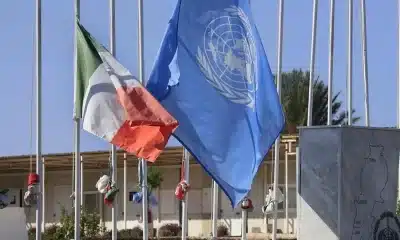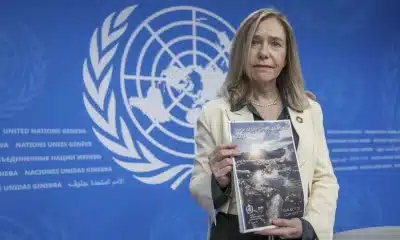News
UN Ocean Treaty Talks Resume With Goal To Save Biodiversity

United Nations members gather in New York on Monday to resume efforts to forge a long-awaited and elusive treaty to protect the world’s marine biodiversity.
On the high seas, nearly two-thirds of the ocean is outside national borders, where fragmented and unevenly enforced rules seek to minimize human impacts.
The United Nations meetings, which will last until March 3, aim to produce a unified agreement for the conservation and sustainable use of those vast marine ecosystems. The talks, formally known as the Intergovernmental Conference on Marine Biodiversity of Areas Beyond National Jurisdiction, resume talks that were halted last fall due to a lack of agreement on a final treaty.
“The ocean is our planet’s life support system,” said Boris Worm, a marine biologist at Canada’s Dalhousie University. “We didn’t feel we had much impact on the high seas for a long time. But that has changed as deep sea fishing, mining, plastic pollution, climate change, and other human disturbances have increased.
The United Nations talks will center on key issues such as who should draw the boundaries of marine protected areas and how. How should institutions evaluate the environmental consequences of commercial activities like shipping and mining? And who has the authority to enforce the rules?
An Agreement Is Urgently Needed To Save The Oceans And Our Planet
“This is our largest global commons,” said Nichola Clark, an oceans expert for the nonpartisan Pew Research Center in Washington, D.C. “We are optimistic that the next round of negotiations will result in a treaty being signed.”
The talks’ goal is not to designate marine protected areas but to create a mechanism for doing so. “The goal is to create a new organization that will accept submissions for specific marine protected areas,” Clark explained.
According to marine biologist Simon Ingram of the University of Plymouth in England, an agreement is urgently needed. “It’s a pressing time for this, especially with things like deep-sea mining that could be a real threat to biodiversity before we’ve even surveyed and understood what lives on the ocean floor,” Ingram said.
Experts believe a global oceans treaty is required to enforce the United Nations Biodiversity Conference’s recent pledge to conserve 30% of the planet’s oceans and land.
“We need a legally binding framework that allows countries to work together to achieve these agreed-upon goals,” said Jessica Battle, an oceans governance expert at the World Wide Fund for Nature.
United Nations Is Working Hard To Keep Peace And Protect The World
According to Monica Medina, Assistant Secretary of State for Oceans and International Environmental and Scientific Affairs, the treaty is a priority for the United States. “For the first time, this agreement seeks to establish a coordinated approach to establishing marine protected areas on the high seas,” she explained. “It’s time to complete the task.”
Officials, environmentalists, and representatives of global industries that rely on the sea are all keeping a close eye on the negotiations.
Gemma Nelson, a Samoan lawyer and Ocean Voices fellow at the University of Edinburgh, stated that small Pacific and Caribbean island countries were “especially vulnerable to global ocean issues” such as pollution and climate change, which they did not cause and did not have the resources to easily address.
“Getting the traditional knowledge of local people and communities recognized as valid,” she added, is also critical to protecting ecosystems and Indigenous groups’ ways of life.
With high seas covering nearly half of the planet’s surface, the talks are critical, according to Gladys Martnez de Lemos, executive director of the nonprofit Interamerican Association for Environmental Defense, which focuses on environmental issues in Latin America.
“The treaty should be strong and ambitious, with authority to establish high and fully protected high seas zones,” she said. “At the United Nations these weeks, half of the world is at stake.”
SOURCE – (AP)
News
Britain Must Be Ready for War in 3 Years, Warns New Army Chief

The new head of the Army has stated that Britain must be prepared to fight a war within three years.
Gen Sir Roland Walker has issued a warning about a variety of risks in what he calls a “increasingly volatile” environment.
However, he stated that war was not inevitable and that the Army had “just enough time” to prepare to prevent conflict.
He stated that the Army’s fighting capacity would be doubled by 2027 and tripled by the end of the decade.
Gen Walker warned that the Britain was under threat from a “axis of upheaval” in his first speech as Prime Minister on Tuesday.
Among the primary concerns confronting the Britain in the next years, as noted by the general in a briefing, is an enraged Russia, which may seek vengeance on the West for helping Ukraine, regardless of who wins the war.
He stated: “It doesn’t matter how it finishes. I believe Russia will emerge from it weaker objectively – or completely – but still very, very dangerous and seeking some form of retaliation for what we have done to assist Ukraine.”
Britain’s Government Defence Review and Military Challenges
He also warned that China was determined to retake Taiwan, and Iran was likely to seek nuclear weapons.
He stated that the threats they posed may become particularly acute in the next three years, and that these countries had formed a “mutual transactional relationship” since the war in Ukraine, sharing weaponry and technology.
However, he stated that the path to conflict was not “inexorable” if the UK re-established credible land troops to assist its deterrent strategy for avoiding war.
In his speech, he described his force of slightly over 70,000 regular troops as a “medium-sized army” and made no direct call for additional resources or men.
However, he pushed the British Army to adapt swiftly, focussing on technology such as artificial intelligence and weaponry rather than numbers.
His ultimate goal is for the Army to be capable of destroying an opponent three times its size.
This would entail firing quicker and farther, he said, aided by lessons learnt from the Ukraine war.
The general’s speech at the Royal United Services Institute land warfare conference comes only one week after the government began a “root and branch” defence review to “take a fresh look” at the challenges facing the armed services.
Defence Secretary John Healey launched the assessment, describing the existing status of the armed forces as “hollowed-out” and stating that “procurement waste and neglected morale cannot continue”.
According to the most recent Ministry of Defence (MoD) numbers from April 2024, the Britain’s regular Army forces total 75,325 troops (excluding Gurkhas and volunteers).
That figure has been declining in recent years, as recruiting has failed to match retention. The previous Conservative administration lowered the planned headcount from 82,000 to 72,500 by 2025.
Members of the NATO military alliance have agreed to spend at least 2% of GDP on defence by 2024, but several countries are unlikely to fulfil this goal.
The Britain presently spends 2.3% of its GDP on defence. Prime Minister Sir Keir Starmer has previously stated that the defence review will include a “roadmap” for increasing this to 2.5%, however he has yet to provide a date for this promise.
Source: BBC
News
Katie Ledecky Hopes For Clean Races At Paris Olympics In The Aftermath Of The Chinese Doping Scandal

PARIS — Katie Ledecky is looking for clean Olympic races. On Wednesday, Hope had pretty much reached her limit.
The American swimmer hopes to add to her six gold medals as she competes in the 400, 800, and 1,500 meters at the Paris Games. Her program starts with the heavy 400 on Saturday, featuring Ariarne Titmus and Summer McIntosh.

Katie Ledecky | ESPN Image
Katie Ledecky Hopes For Clean Races At Paris Olympics In The Aftermath Of The Chinese Doping Scandal
The 27-year-old Katie is competing in her fourth Summer Olympics, but the first since a doping scandal involving almost two dozen Chinese swimmers who tested positive for a banned chemical before the Tokyo Games — yet were permitted to compete with no consequences. The controversy has raised serious worries regarding the effectiveness of anti-doping initiatives.

Katie Ledecky | Vogue Image
“I hope everyone here is going to be competing clean this week,” Ledecky claimed. “But what truly counts is, were they training cleanly? Hopefully this has been the case. Hopefully, there has been worldwide testing.”
The International Olympic Committee has expressed concern over the ongoing US investigation into possible doping by Chinese swimmers. While awarding the 2034 Winter Olympics to Salt Lake City on Wednesday, the IOC urged Utah officials to do whatever they could to stop the FBI investigation.
“I think everyone’s heard what the athletes think,” Katie added. “They seek transparency. They want more answers to the remaining questions. At this point, we are here to race. We are going to race whoever is in the lane next to us.
“We are not paid to conduct the tests, so we trust those who follow their regulations. That applies both today and in the future.

Katie Ledecky | ESPN Image
Katie Ledecky Hopes For Clean Races At Paris Olympics In The Aftermath Of The Chinese Doping Scandal
SOURCE | AP
News
London Heatwave Alert: High Temperatures Set to Soar to 29C Next Week

As the summer holidays begin, London may experience an official heatwave with temperatures reaching up to 29 degrees Celsius.
The Met Office predicts a long period of sunny and dry weather for London after a soggy spring and summer.
After a cloudy day on Saturday, temperatures are expected to reach 27C on Sunday, with lots of sunlight.
On Monday and Tuesday, temperatures are forecast to peak at 29 degrees Celsius. Monday is forecast to offer more sunlight, while Tuesday may see some gloomy weather.
Temperatures are expected to remain in the high 20s next week, with lows of approximately 18C.
According to the Met Office, a heatwave is “an extended period of hot weather relative to the expected conditions of the area at that time of year, which may be accompanied by high humidity.”
In the United Kingdom, a heatwave is proclaimed when daily temperatures meet or surpass a certain level for at least three consecutive days.
In London, the heatwave threshold is 28 degrees Celsius.
The Met Office reported that the UK is experiencing hotter and wetter weather on average due to climate change.
The UK experienced its warmest May and April on record this year, despite damp and dismal conditions in many areas.
According to the Met Office’s State Of The UK Climate 2023 report published on Thursday, the UK experienced historic levels of extreme weather last year.
In the United Kingdom, 2023 was the second warmest year on record, bringing storms, flooding, strong heatwaves, and rising sea levels; only 2022 was warmer.
It was 0.8°C higher than the average from 1991 to 2020, and 1.66°C higher than the 1961 to 1990 average.
However, 2023 will be a “cool year” in comparison to 2100, based on the planet’s warming trajectory.
The government’s plan to adapt to the hazards presented by climate change is currently being challenged in the High Court by campaigners who allege the Tory administration’s July 2023 National Adaptation Programme (NAP) fails to adequately address 61 concerns.
Source: The Standard
-
World2 weeks ago
Former President Trump Survives Being Shot at Pennsylvania Rally
-
Tech4 weeks ago
Huawei Launches 5G-A Pioneers Program at MWC Shanghai 2024: Paving the Way for a Connected Future
-
Sports4 weeks ago
NBA Draft: Kyle Filipowski Withdraws Unexpectedly From The First Round
-
Tech4 weeks ago
ChatGPT Answers Undiscovered Questions and Outperforms Students.
-
News4 weeks ago
US Supreme Court Rejects Drug Deal that Protects the Sackler Family
-
Health4 weeks ago
US Health Agency Issues Dengue Virus Infection Warning


























